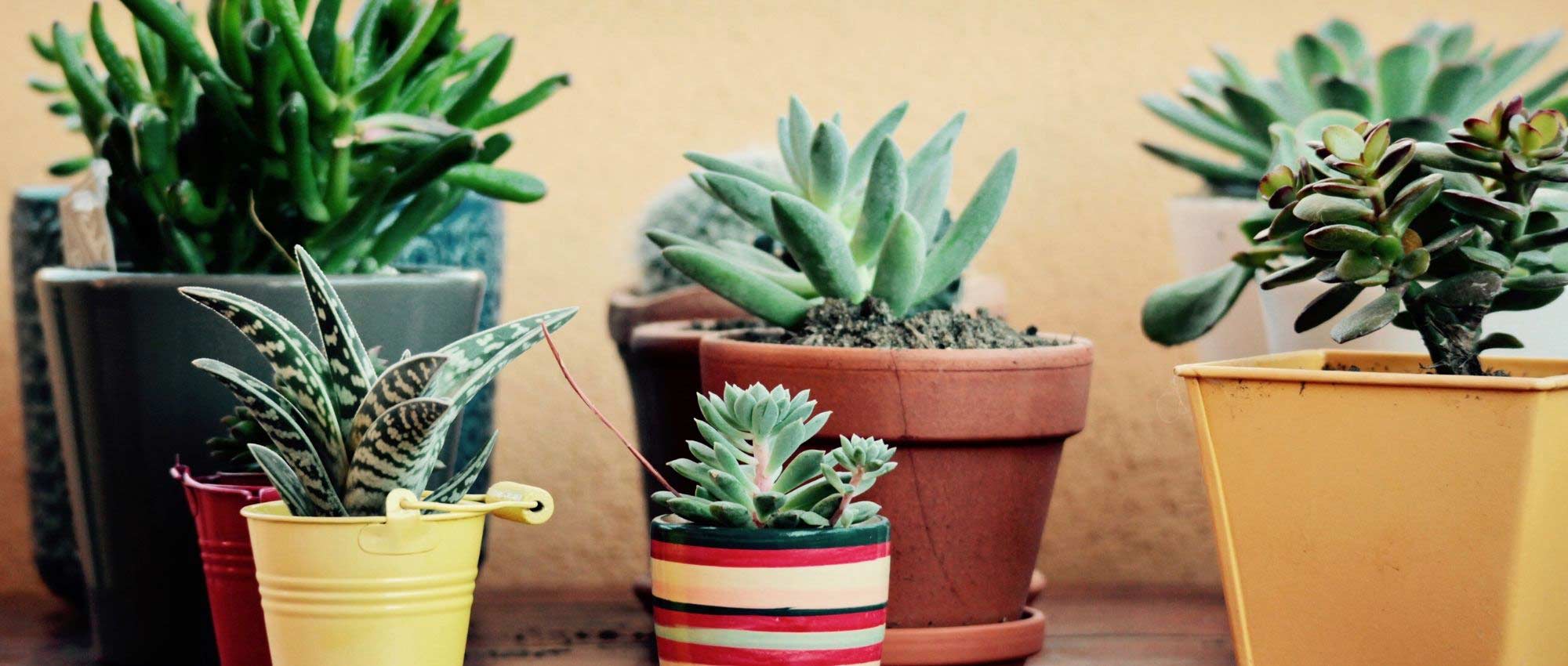
Cacti and indoor succulents: how to grow and care?
Contents
Cacti and succulents in a nutshell
- Very drought-resistant, cacti and succulents require little maintenance
- They need a light, well-draining substrate, as well as excellent brightness
- Graphic and original, they are perfect for decorating an interior
- They offer an incredible diversity in terms of shapes and colours
- When they bloom, cacti bear stunning flowers in bright, light shades!
A word from our Expert
Cacti and succulents are truly unique plants, distinguished by their shapes and cultivation methods. They have a strong reputation as indestructible plants that can easily be forgotten, and they are among the most drought-resistant plants.
Succulent plants can take on a wide variety of forms, but they often have fleshy, thick leaves and stems, allowing them to store water and minerals. They are also known as succulents. They are often mini-plants, as they grow slowly and generally do not become very large. They can form rosettes of leaves, have a trailing habit, or resemble dwarf bushes. They allow for stunning displays by combining several succulents with varied shapes and colours.
Among succulents, cacti are distinguished by their swollen stems and thorns. They also offer exceptional flowering, often featuring large, brightly coloured flowers.
Cacti and succulents are frost-sensitive plants, which is why most species should be grown indoors. It is important to plant them in well-draining substrate and to adjust watering according to the time of year. Discover all our tips for successfully cultivating your succulents and cacti, caring for them, and making them bloom!
Botany
Botanical data
- Family Cactaceae, Crassulaceae...
- Common name cactus, succulents
- Flowering colourful, very decorative in cacti
- Height highly variable, between 10 cm and 15 m
- Exposure bright, sunny
- Soil type dry, draining, sandy
- Hardiness generally low, but there are some hardy species
Growing naturally in a dry and warm environment, succulents and cacti have developed strategies to survive these particular conditions and withstand water scarcity. Their morphology has adapted, allowing them to endure long periods of drought and to cope with intense sunlight. This is why their appearance is so different from plants growing in cooler, shaded environments.
These xerophytes (= adapted to dry environments) store water and minerals in their tissues in the form of sap, which is why they are called “succulents.” They have evolved strategies to limit water loss and survive for extended periods without rain. They also have a CAM (Crassulacean acid metabolism) metabolism, closing their stomata during the day to prevent water evaporation and opening them at night. Thus, unlike other plants, they capture carbon dioxide at night rather than during the day.
However, it is important to distinguish between these plants: cacti are succulents (also known as fleshy plants), but not all succulents are cacti.
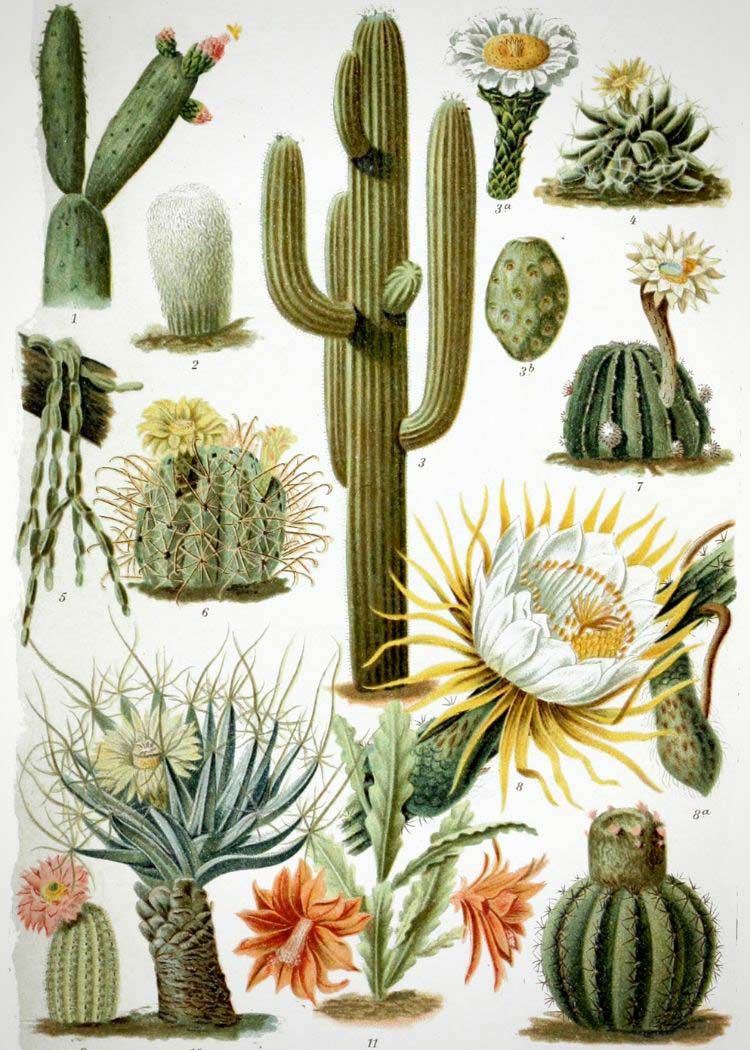
Botanical illustration depicting various species of cacti
Cacti belong to the family Cactaceae, also known as Cactae. This family includes over 2,200 species. Cacti are almost exclusively native to North and South America, where they primarily grow in arid and semi-desert regions. They can originate from warm temperate or tropical areas.
The term “succulents” (or fleshy plants) is broader: it encompasses various plant families, including Cactaceae. What unites them is the presence of fleshy, thick leaves and drought resistance. Among these plants, the Crassulaceae family is quite significant, with nearly 1,500 species: Echeveria, Kalanchoe, Aeonium, Sedum, etc. The name Crassulaceae comes from the Latin Crassus: thick, due to the swollen tissues of these plants. Other fleshy plants belong to the families Xanthorrhoeaceae (Aloe, Haworthia…) or Asparagaceae (Agaves…).
Some succulents, particularly euphorbias, resemble cacti because they have been subjected to the same natural constraints (heat and drought) and have thus had to adapt similar evolutionary strategies: thickening of the stem, loss of leaves, and development of spines, etc. This is a convergence of forms. However, cacti can be recognised by the presence of areoles: this term refers to small growths from which spines are inserted. This is one of the characteristics that differentiates them from euphorbias. Their name also gives us a clue, as many cacti have a genus name ending in -cereus or -cactus (Hylocereus, Echinocactus, Ferocactus…).
Cacti and fleshy plants are generally not very large. They take a long time to grow and have a slowed metabolism. However, over time, some can become quite large, such as Carnegeia, or Saguaro, the iconic arborescent cacti of the United States. They can reach up to 15 metres in height in their natural environment!
Cacti often have “ribs.” This protects them from the sun by shading part of the plant. It also allows their epidermis to stretch to store water or retract without tearing.
Cacti can take on a spherical, globular shape, as seen in Echinocactus grusonii, commonly known as the Mother-in-law’s Cushion. The stem can also be tall and upright, giving a columnar silhouette (candle cacti…). Stems can also be flattened, paddle-shaped, as in Opuntia. The Cereus forbesii Spiralis has a very unique shape: instead of being straight and vertical, the ribs of its stem are spiralled. Some cacti are epiphytic (growing on other plants rather than in the ground) and have trailing branches: this is the case, for example, with Hylocereus undatus. There are even climbing cacti, such as Selenicereus, which climb along tree trunks.

Cacti can take on various forms: Echinopsis chamaecereus, Astrophytum myriostigma, and Mammillaria elongata ‘Cristata’ (photos 2 and 3: Resenter1 / David J. Stang)
There are also cacti with monstrous, cristate, or fasciated forms, resulting from mutations. In the case of cristation, the top of a stem takes on an enlarged shape, resembling a crest or fan. This is the case, for example, with Mammillaria elongata ‘Cristata’. In the case of fasciation, the stems form bundles. Discover Virginie’s article on our blog: Fasciation and cristation, plant chimeras.
In cacti, leaves are replaced by spines, thus limiting water loss through evaporation. In addition to being an excellent means of defence against herbivores, this also allows them to capture dew or protect themselves from the sun or cold. Spines can come in various colours (white, cream, yellow, brown…) and can be well-developed and sharp or, conversely, very small. They are sometimes very decorative. There are also cacti that do not have spines (Astrophytum, Epiphyllum…).
Cactus spines can be replaced by glochids: tiny prickles grouped in small tufts, which are particularly difficult to remove from the skin.
Without true leaves, in cacti, the stem is responsible for photosynthesis. However, there are a few cacti that have retained their leaves: these are Pereskia. They are primitive, archaic cacti that resemble shrubs more than other members of this family.
In succulents, water and minerals can be stored in the leaves, stems, and roots, giving these tissues a swollen, fleshy appearance. When the base of the trunk is swollen, it is called a Caudex. In fleshy plants, the leaves are particularly thick. The epidermis is covered with a thick, waxy cuticle, which protects them from the sun and limits water evaporation.
Some succulents form rosettes of leaves: this is the case, for example, with Aloes, Agaves, Haworthia, or Echeveria. Others have a stout silhouette, formed of branched stems and trunks, resembling a miniature shrub or bonsai: Crassula ovata, Aeonium haworthii or A. arboreum. Sedum morganianum and Sedum burrito have trailing stems formed of numerous globular, thick leaves. We can also mention Lithops, or living stones: small, very discreet plants that form a plateau at ground level and often take on a brown-grey hue, mimicking stones. This is a true camouflage to escape herbivores in their natural habitat!

Fleshy plants offer exceptional diversity! Senecio rowleyanus (photo Maja Dumat), Crassula ovata Gollum, and Lithops marmorata (photo Abu Shawka)
Fleshy plants can take on various hues: dark green, light green, bluish, purplish… There is beautiful diversity among Crassula and Aeonium. The leaves of Crassula often turn red when exposed to sunlight.
Cacti generally produce beautiful, large, colourful flowers with many petals. They are usually solitary and bisexual. Their colours are often bright and vivid: yellow, pink, red, orange… sometimes white. Many species of cacti have nocturnal flowers that open at night. The blooms are surprising, large compared to the size of the cactus.
For them to flower, it is important to place them in a cool room in winter, with a temperature between 5 and 15 °C, and to stop watering during this period. Then, in spring, they should be placed in a well-lit spot and gradually acclimatised to the sun. This helps to replicate the conditions they experience in nature, thus encouraging them to bloom!

The flowering of Echinopsis subdenudata, Echinopsis chamaecereus, and Mammillaria craigii (photos 1 and 3: Christer Johansson / msscacti)
Some cacti have swollen roots, described as napiform (turnip-shaped), resembling a tubercle. These very thick roots allow them to store water. Others, like Carnegiea, have a very extensive, shallow root system. This enables them to capture the slight moisture that sometimes settles on the ground.
Some species of cacti are appreciated for their edible fruits: for example, Hylocerus undatus, which produces the Pitaya or Dragon Fruit, and Opuntia ficus-indica, which produces the prickly pear.
The main varieties of indoor cacti and succulents
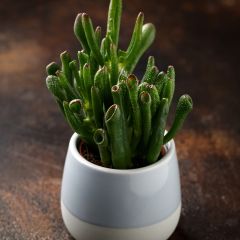
Crassula ovata Hobbit
- Height at maturity 1 m
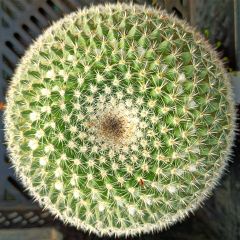
Mammillaria perbella
- Flowering time June, July
- Height at maturity 10 cm
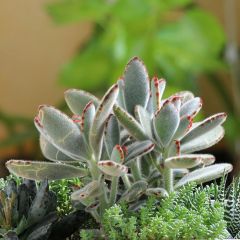
Kalanchoe tomentosa
- Flowering time February to May
- Height at maturity 40 cm
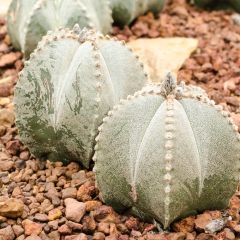
Astrophytum myriostigma
- Flowering time July to October
- Height at maturity 50 cm
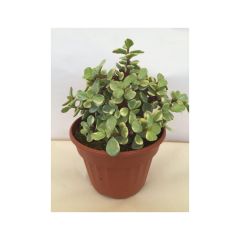
Portulacaria afra Variegata
- Flowering time June, July
- Height at maturity 2 m
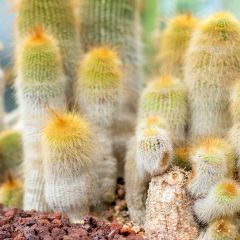
Parodia leninghausii
- Flowering time July to September
- Height at maturity 80 cm
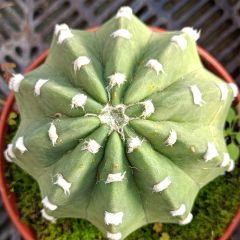
Echinopsis subdenudata
- Flowering time June
- Height at maturity 20 cm
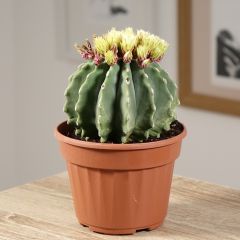
Ferocactus glaucescens Inermis
- Flowering time July to September
- Height at maturity 50 cm
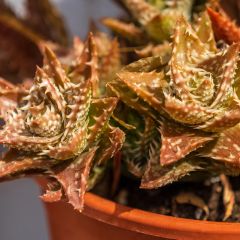
Aloe squarrosa
- Flowering time July to October
- Height at maturity 30 cm
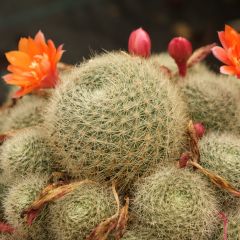
Rebutia sp.
- Flowering time April to July
- Height at maturity 10 cm
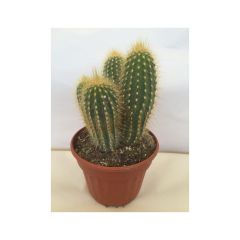
Vatricania guentheri
- Flowering time August, September
- Height at maturity 2 m
Discover other Cacti and succulents
View all →Available in 0 sizes
Available in 1 sizes
Available in 1 sizes
Available in 1 sizes
Available in 1 sizes
Available in 1 sizes
Available in 1 sizes
Available in 1 sizes
Available in 1 sizes
Available in 1 sizes
Planting
Where to grow cacti and succulent plants?
Thriving in full sun in arid regions, cacti and succulent plants require excellent light conditions. The ideal situation would be to place them in a conservatory, but you can also position them near a window. When these plants lack light, there is a risk of etiolation (the stems elongate and become very thin). Most prefer direct sunlight (this is true for cacti and Echeveria, for example), but they need gradual hardening to avoid burning.
However, there are also some cacti and succulent plants that naturally grow in the shade. Research the needs of the species you are cultivating. For instance, it is better to avoid direct sunlight for Aloe vera and Parodia leninghaussii.
In any case, avoid growing them in a terrarium! Although you can find succulent plant compositions in terrariums commercially, or see tutorials online for making them, we advise against it. Indeed, terrariums have poor air circulation, inadequate drainage, and a humid atmosphere… Conditions that can lead to the rotting of succulent plants. Moreover, while these plants enjoy sunlight, you cannot place a terrarium in direct sunlight, as the temperature would quickly become too high for them!
Also, make sure to check the hardiness of your cacti and succulent plants. Some species can withstand cold and need to be grown outdoors. This is the case for hen-and-chick plants and most sedums. Discover our selection of the hardiest cacti and succulent plants.
Which substrate to use?
Cacti and succulent plants generally grow in very well-draining, dry soils that are low in organic matter.
It is important that the substrate is light, sandy, and aerated, to avoid suffocating the roots. Water should be able to drain quickly and allow the substrate to dry easily.
We recommend planting your cacti and succulent plants in a mix of one-third coarse sand (river sand), one-third potting soil, and one-third sifted garden soil (avoid this if it is very clayey). You can also use special cactus potting soil.
How to plant?
You can choose a plastic or terracotta pot. Plastic pots retain more moisture, while water evaporates more quickly in terracotta pots, so watering will need to be adjusted accordingly. In any case, use a pot with drainage holes at the bottom to allow excess water to escape.
- Install a drainage layer at the bottom of the pot, using gravel, pumice, or broken pieces of terracotta pot.
- Place a draining substrate in the pot, such as special cactus potting soil, or a mix of coarse sand, potting soil, and garden soil.
- Plant your cactus or succulent. To handle a cactus without injuring yourself, we recommend wrapping it in several layers of newspaper.
- Replace substrate around the cactus to secure it, but be careful not to bury the collar.
- You can add a layer of small gravel on top of the substrate to protect the plant from moisture.
- Do not water after planting or repotting! Wait at least 15 days for the roots to heal to avoid the risk of rot.
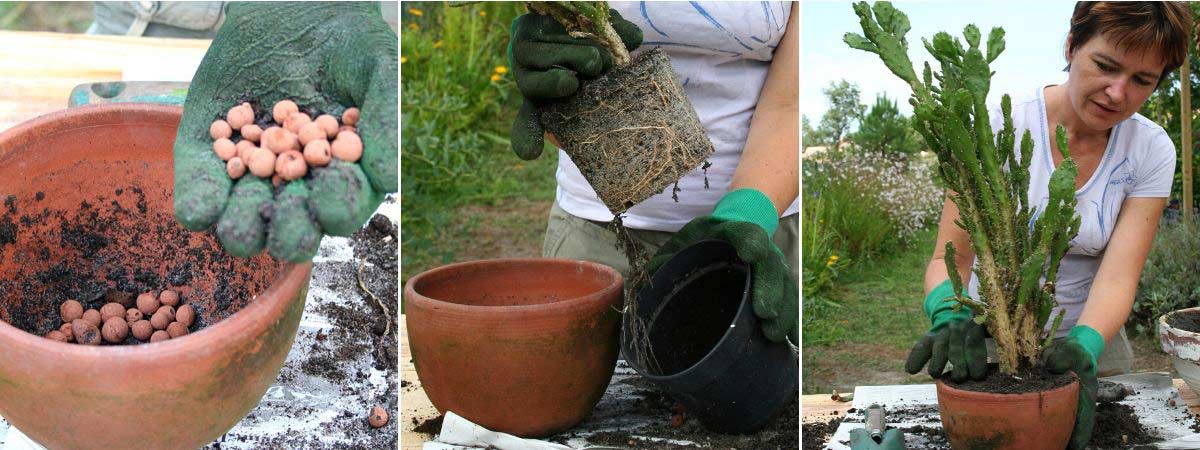
Planting a cactus in a pot
Discover our articles to learn more:
Read also
10 hardy plants for an exotic dry gardenCare
On tends to think that cacti require very little water, and it is true that excess moisture can kill a cactus more easily than a lack of water. However, even though they tolerate drought well, to have beautiful cacti and encourage their flowering, watering should not be neglected. We recommend watering them regularly throughout the growing season, from spring to autumn, approximately every 15 days. During summer, you can water once a week. In very hot periods, it is better to stop watering, as some cacti enter dormancy. Similarly, cacti should not be watered in winter.
Regarding succulents, some continue to grow in winter (Crassula, Aeonium, certain euphorbias…), so they should be watered occasionally (once or twice a month at most). Observe your plants to determine if they are dormant or not.
→ Also read: “Preparing your succulents for winter: our tips and tricks“.
Preferably water with rainwater. If not, tap water will also suffice, provided it is not too hard.
Water generously, ensuring that the entire substrate is moist. Then empty the saucer, as water should not stagnate, allowing the substrate to dry quickly. Ensure it is completely dry before watering again.
You can water by immersion, pouring water into a bowl or saucer, then letting the pot soak. Once the entire substrate is moist, remove the pot and let it drain.
For more information, you can consult our sheets How to water a cactus?, Cactus watering: mistakes to avoid and How to water your succulents correctly?.
Although they are low-maintenance plants, your cacti and succulents will appreciate some fertiliser. Preferably choose a liquid cactus fertiliser, low in nitrogen. Alternatively, a fertiliser for geraniums and flowering plants will also work. You can apply fertiliser once a month, diluted in the watering water, throughout the growing season (from spring to autumn). Stop fertilising in winter.
Fertiliser needs are less significant if you repot them regularly.
Cacti need a resting period in winter, during which they should remain cool and dry. Ideally, place them in a room where the temperature is between 5 and 10 °C, although for some species, temperatures can go up to 15 °C. Research the ideal winter temperatures for the species you are growing. The Schlumbergera, for example, can stay warm.
In spring, gradually resume watering. You can also start fertilising again. From May onwards, you can take them outside. However, be careful not to expose them immediately to direct sunlight: they need to be acclimatised gradually to avoid burning. Initially, shade them during the hottest hours.
We recommend repotting your cacti every two to three years, preferably at the beginning of spring. Remove the cactus from its pot, and remove the old substrate and dead roots. Prepare a pot slightly larger than the previous one, placing a drainage layer at the bottom, and use special cactus soil, then plant. After repotting your cactus or succulent, wait about 15 days before resuming watering.
You can also occasionally use a soft-bristled brush on your cacti or succulents to remove dust that may settle between the spines or ribs of the cacti, or on the branches or leaves of the succulents.
→ Also read: Growing cacti indoors: light, substrate, watering… everything you need to know! and Getting cacti to flower: our foolproof solutions and tips.
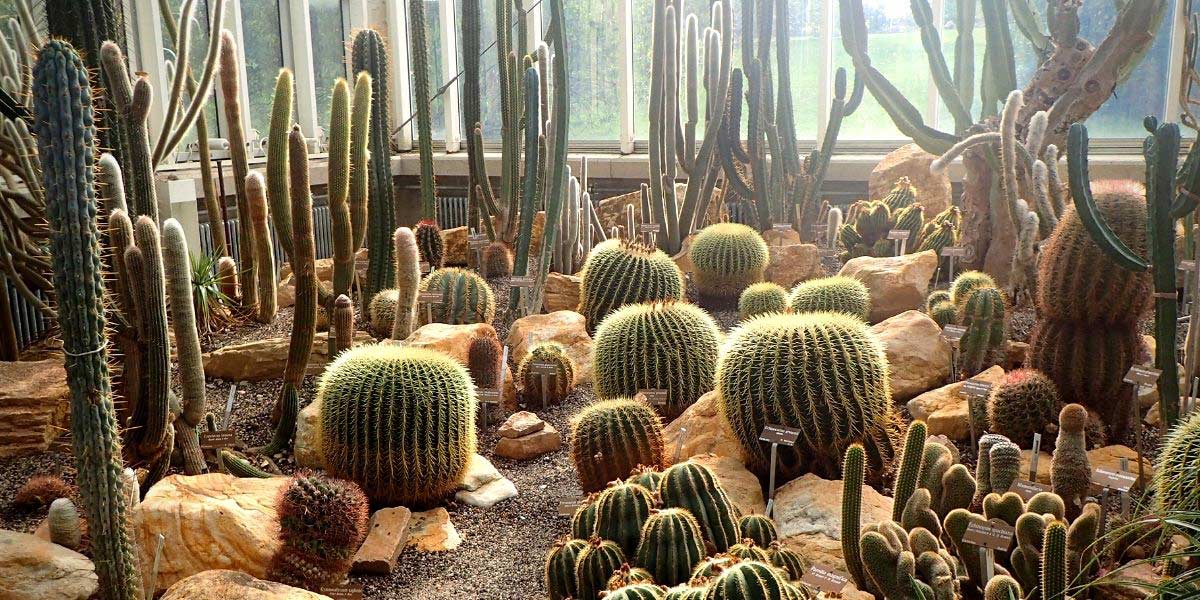
A collection of cacti, including many Echinocactus grusonii, at the Botanical Garden of Geneva
Diseases and pests
Cacti and succulents can be attacked by mealybugs, which form white, powdery clusters. To get rid of them, use black soap diluted in water. They can also be affected by red spider mites, which particularly thrive in warm, dry conditions. We recommend regularly ventilating the room where you grow your cacti, and possibly spraying an acaricide.
Root aphids are more difficult to spot, as they are located underground. You may see small, powdery white clusters around the roots. The affected plant stops growing and can die in the case of a severe infestation. We advise you to unearth the affected cactus, clean its roots, and repot it in a new pot disinfected with bleach, using healthy substrate.
In cases of excess moisture, cacti and succulents risk rotting. They can be affected by fungal diseases. When a cactus is affected by a disease, the affected parts usually begin to soften gradually. If the affected areas are not extensive, it is possible to remove them with a disinfected, sharp knife. An antifungal should then be applied. If the damage is more extensive, we recommend propagating the cactus by taking cuttings from the healthy parts to save it.
Read also: Diseases and pests of indoor cacti: how to treat and prevent them?
Multiplication
To multiply cacti, we recommend propagation by cuttings, as this technique is simpler and less demanding than sowing.
Sowing
Sow preferably in spring, around May. Some cacti are easier to germinate than others. If you are a beginner, we recommend sowing Hylocereus, Mammillaria, Echinopsis, or Rebutia. Conversely, sowing Opuntia and Copiapoa is more challenging.
- Prepare a pot or seed tray by filling it with a draining medium (for example, a mix of potting soil and sand). It is also important that the pot has drainage holes at the bottom to prevent excess moisture. You can also sterilise the medium beforehand by microwaving it to ensure it does not contain any pathogenous organisms. Gently compact the medium and level it out.
- Distribute the seeds evenly on the surface. Do not cover them!
- Water gently, using a spray bottle, or by bottom watering by soaking the pot in a saucer filled with water.
- Place the pot in a bright, airy location, out of direct sunlight. The temperature should be between 25 and 30 °C. The higher the temperature, the faster the germination.
- Ensure the medium remains slightly moist until the seeds germinate. It is important that it does not dry out! Once the seeds start to germinate, space out the waterings. The medium should be allowed to dry between waterings to prevent the seedlings from rotting. You can also treat with Bordeaux mixture or another fungicidal solution mixed with the watering water.
Propagation by cuttings
Propagation by cuttings has the advantage of being a relatively simple and quick technique for multiplying cacti and succulents. It is also useful for saving plants that are sick or damaged by taking cuttings from healthy parts. Additionally, it allows for the identical multiplication of horticultural varieties, as well as cacti with cristate or fasciated forms.
Propagation by cuttings is particularly suitable for multiplying Opuntia, Cereus, and Mammillaria.
The best time to take cuttings from your cacti and succulents is from mid-spring to early summer.
- Take a sharp knife and disinfect it to avoid transmitting diseases.
- Cut the part of the cactus to be propagated. It should be healthy, free from diseases or pests. To remove it, you can use newspaper to avoid pricking yourself on the cactus thorns.
- Sprinkle charcoal powder on the wound to prevent the onset of diseases.
- Let the cutting dry: this period can last from a week to several months, depending on the size of the cutting. Place it in a cool, dry, well-ventilated area, out of direct sunlight. Wait for a callus to form on the cut surface.
- Once the cutting has healed, plant it in a pot filled with a draining medium, and place the pot in a bright location, out of direct sunlight.
Leaf cuttings:
This technique is ideal for multiplying succulent plants with fleshy leaves (sedums, echeverias, etc.).
- Take a healthy, well-formed leaf.
- Let it dry for a few days. This will prevent it from rotting.
- Prepare a pot with a draining medium (a mix of potting soil and sand, or special cactus soil).
- Simply place the leaf on the medium, or lightly bury the base of the leaf.
Some succulents, particularly Kalanchoe daigremontiana, produce bulbils on their leaves: these are small plantlets attached to the edge of the lamina, forming small leaves and roots. As they grow, they detach and fall onto the medium where they can root. It is therefore very easy to multiply these plants by taking the bulbils and replanting them in the medium.
 The bulbils of Kalanchoe daigremontiana (photos: Anneli Salo / Aurélien Mora)
The bulbils of Kalanchoe daigremontiana (photos: Anneli Salo / Aurélien Mora)
→ Discover our Tutorial “Taking Cuttings from Cacti and Succulents”
Useful resources
- Discover our range of cacti and succulents
- Au Cactus Francophone, an excellent site on the cultivation of cacti and succulents
- Discover our guide on growing Aloes
- Our guide Opuntia, Prickly Pear Cactus: Planting, Cultivation and Care
- Cactus Encyclo, an encyclopedia on cacti, with numerous resources and cultivation information
- Find all our tips on cacti and succulents and our selection of indoor cacti: the easiest species to grow
- Some tips from Angélique with How to create a beautiful display of succulents?
- Our tips for growing succulents indoors
- How to fail at caring for your cacti and succulents in 6 lessons: a humorous article to learn what not to do
- Our tutorial: How to create mini-terrariums with succulents for your wedding guests?
Frequently asked questions
-
How to make cacti bloom?
To make them flower, you need to mimic natural conditions by wintering them in a cool place without water. This will allow them to sense the difference between the seasons, inducing flowering. To do this, in autumn, place them in a room where the temperature is between 5 and 10 °C, and stop watering. Then, in spring, gradually start watering them again and position them in a bright location. After that, you can slowly introduce them to direct sunlight (initially shading them during the hottest hours).
-
Why is my succulent losing its leaves?
If the leaves become soft and yellow, it is likely due to overwatering. Make sure to allow the substrate to dry out between waterings, and also remember to empty the water from the saucer when you water. It may also be that your plant is lacking in light. Leaves can also drop if there is a lack of water (especially if they become dry and wrinkled).
-
Can they be put outside in summer?
We do recommend bringing your cacti and succulents outdoors during the summer. Most of them can be placed outside from late May to early June, although this also depends on the species: some are sensitive when temperatures drop below 10 °C, while others can tolerate temperatures close to 0 °C. Most cacti and succulents will thrive if you position them in the sun, after gradually acclimatising them.
-
Why is my cactus rotting?
Excess moisture may be the issue, especially if the substrate is not well-draining, if the atmosphere is humid, or if watering is too frequent. Be aware that even when watered sparingly, cacti and succulents can rot if the surrounding air is relatively humid. It is also possible that your plant is suffering from a lack of light. We recommend checking that the conditions are suitable: the substrate should be able to dry completely between waterings, and the location should be sufficiently bright, as most cacti enjoy sunlight. A cactus can also rot if it has been exposed to cold and not protected during winter.
To save a cactus that has started to rot, we advise cutting away the damaged parts, if they are not too extensive, or taking healthy sections for propagation. Then, apply charcoal powder or a fungicidal treatment to the wound.
-
Why is my cactus turning white?
In general, when a cactus turns white, it is due to sunburn. If it was previously in a shaded or partially shaded position and you place it directly in the sun, the epidermis may get burned, which is why it is important to acclimatise the cactus gradually.
Cacti can also lose their colour due to a lack of light. In this case, they tend to become elongated: the stems become thinner and stretched as the plant seeks light.
A cactus can also whiten due to a cold snap: the cells freeze and die, leading to discolouration.
An infestation of red spider mites can also cause cacti to discolour, turning them light yellow to brown.
-
The leaves of my succulent plants have black spots, why?
It is likely a case of overwatering! The black spots are caused by a fungus, which is causing the plant to rot. Space out the waterings or repot the plant in well-draining compost.
-
My cactus or succulent is wilting! What should I do?
If you notice that your plant is producing new, thin, elongated, and pale shoots, it means it is lacking light. Move it to a well-lit spot behind a window, and if it's summer and the temperatures are warm enough, feel free to take it outside.
- Subscribe!
- Contents
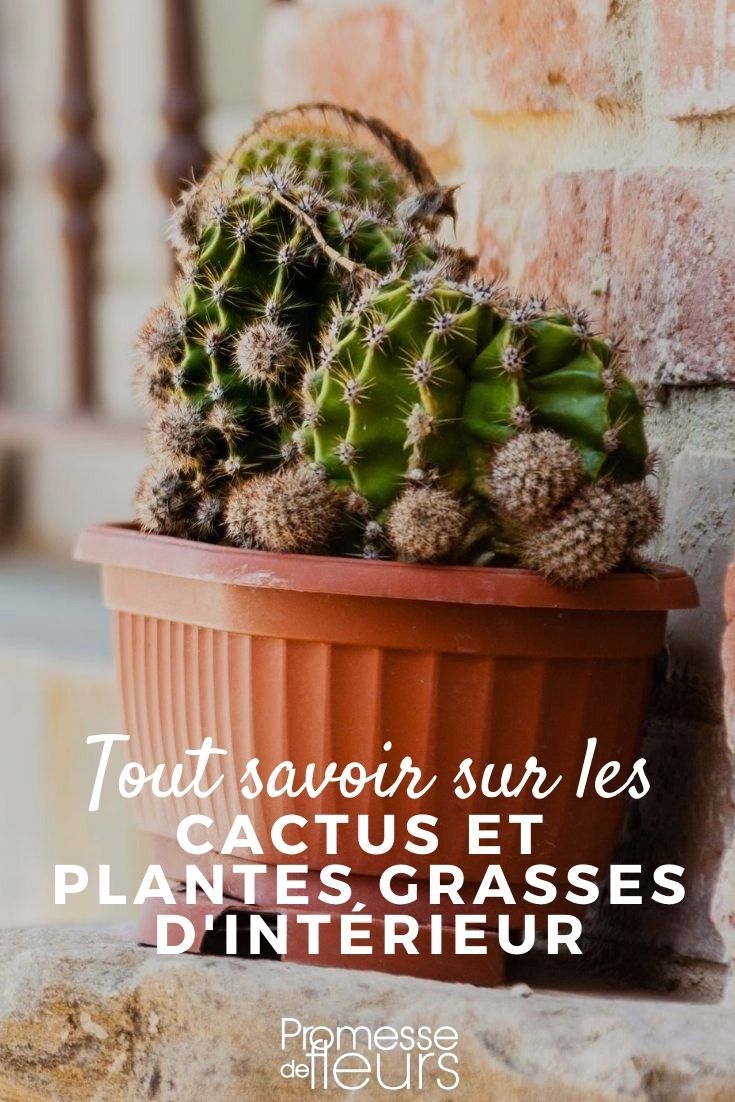































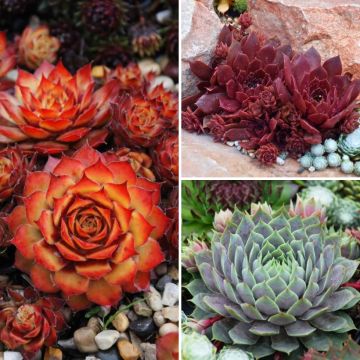
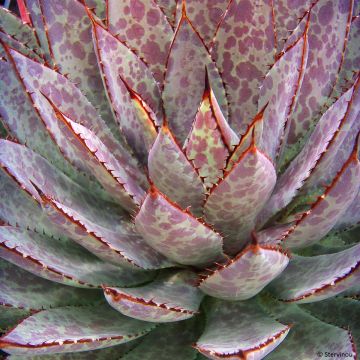
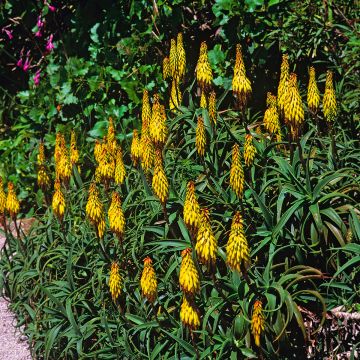
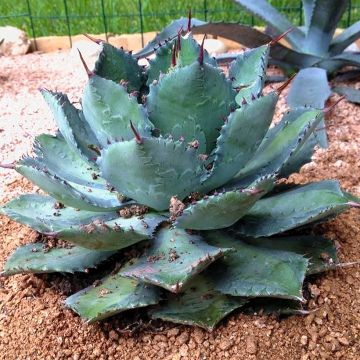
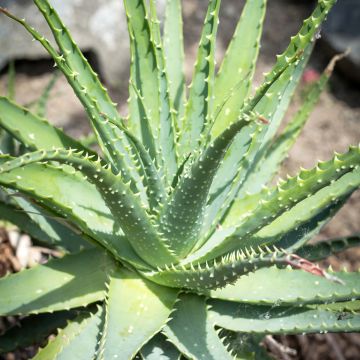
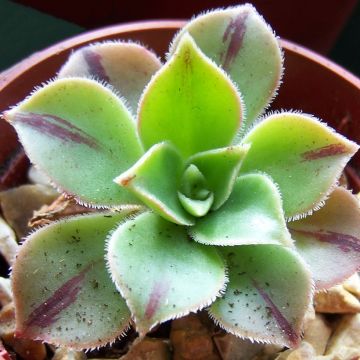
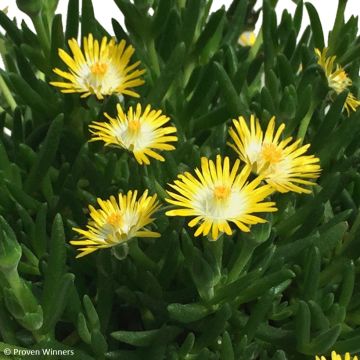
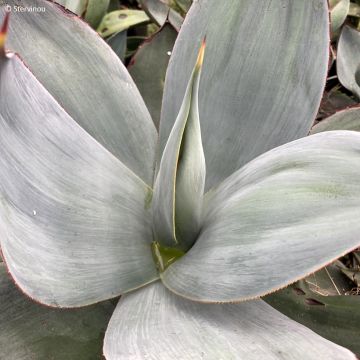
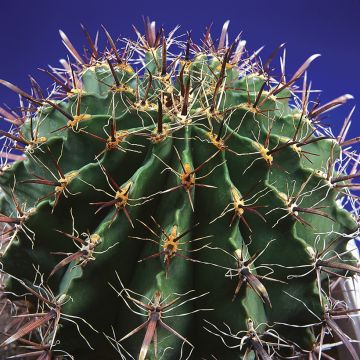
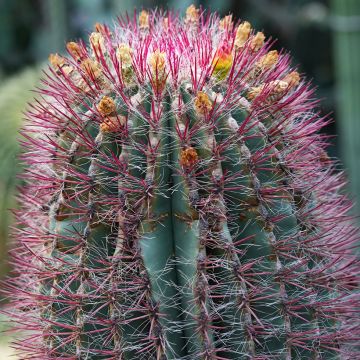
Comments